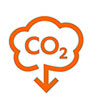Environmental Programme
To make a difference to people and the planet, we have the ambition to play a leading role in accelerating the low carbon transition. We put sustainability at the heart of what we do, and aim to lead by example by striving for net zero in our own operations, by reducing the carbon dioxide equivalent (CO2e) emissions associated with our own activities. That's why we monitor and manage the impact of our operations through our Environmental Programme.
lNG's Environmental Programme, established in 2015, aims to contribute to our climate action approach and to effectively tackle the need for more efficient use of natural resources in our operations.
The Environmental Programme is focused on improving our environmental performance in the following areas:
Energy
One of the largest sources of carbon emissions globally is energy production and consumption. To understand and reduce our energy use, we carry out regular monitoring, reporting and reduction strategies across our global operations. Our strategies range from more efficient use of building space to increasing the energy efficiency of our buildings and data centres, to the sourcing of renewable electricity.
Business travel
As a global bank, communication across our network is key. Traditionally this often resulted in large amounts of business travel. With our digitalisation strategy and as we have shifted to the ‘new normal’ of hybrid working following the Covid-19 pandemic, we are focusing on the increased use of technology for seamless digital collaboration (such as video conferencing) to limit unnecessary business travel. Where business travel is deemed necessary, we mandate or encourage employees to utilise the most sustainable options (such as high-speed rail) and continue to increase the number of electric vehicles in our leased vehicle fleet.
Sustainable procurement
To continue to be a safe and secure bank for our customers and society, it’s important to know our suppliers and ensure they share our commitment to fighting climate change and protecting human rights. We have a process in place that encourages our suppliers worldwide to act responsibly. We believe this is a real opportunity to make an impact and drive our sustainability ambitions through our relationship with these suppliers.
We've included social and environmental responsibility requirements in our procurement process since 2012. ING's Procurement Sustainability Standards were originally based on the UN Global Compact Principles and are now incorporated into our global ‘know our supplier’ (KYS) process. The sustainability part of the current KYS process has evolved and expanded beyond UN Global Compact Principles and also incorporates other social and environmental aspects, e.g. compliance with modern slavery prevention legislation. We aim to only do business with companies that agree to meet our sustainability requirements.
Contribution measures
The priority of our Environmental Programme is to reduce CO2 in our operations. We also take accountability for our unabated emissions and look for ways to contribute to impactful projects that can mitigate climate change outside of our supply chain. In 2023, we started exploring partnerships with organisations with the goal of donating to projects on carbon removal and nature restoration and developing carbon removal technologies. We intend to continue this approach in the future using a contribution model rather than purchasing carbon credits, a practice we stopped in 2022. Moreover, we will not use the environmental impact of any current or future projects for any claims related to carbon neutrality.
Our contributions include a partnership with Milkywire, through the Climate Transformation Fund (CTF). We chose to support Milkywire’s CTF as it seeks to create and build scale for new solutions to tackle climate change. The CTF focuses on climate impact, and thereby not only supports small effective grassroots organisations (for example HUSK, Hierloom, and previously Climeworks) but also climate advocacy projects (for example the Clean Air Task Force), and catalytic research into new carbon removal techniques. Milkywire’s CTF impact first approach focuses on carbon removal and transparent impact reporting. We started supporting this fund in 2022, and the latest impact reporting can be found on the Milkywire site.
Our commitments
We want to show leadership on environmental performance, so we've committed to significant milestones in our specific impact areas.
Our reduction targets
- ING will reduce their scope 1, 2, and scope 3 (business travel) emissions by 23% by year-end 2030 (base year 2023).
- ING commits to reduce absolute scopes 1 and 2 GHG emissions by 44% by 2030 from a 2023 base year. ING commits to increase active annual sourcing of renewable electricity from 98.3% in 2023 to 100% by 2030.
- ING aims to reach 90% electric vehicles in its leased vehicles fleet globally by 2030.
- ING will continue to source 100% renewable electricity for all ING buildings worldwide where we have management control.
Our progress
We have already achieved progress on many of our objectives.
| Theme | Indicator | Unit | 2023 baseline figures | Target (from baseline 2023) | Target year | 2024 results |
| Energy | CO2e emissions (scope 1, scope 2, and scope 3 business travel) | kilotonne CO2e | 29 | −10% | 2025 | −10% |
| Energy | CO2e emissions (scope 1+2) | kilotonne CO2e | 14 | −44% | 2030 | −13% |
| Energy | Sourcing renewable electricity* | % | 73% | Source 100% each year | Since 2020 | Above 98% |
| *for all ING buildings where we have management control. In 2023 98,3% of our sourcing of renewable electricity was aligned with the market boundary criteria of the RE100 initiative. | ||||||
CO2e and emissions

Reducing our direct CO2e footprint is one of ING's key environmental goals. In 2024, we reduced emissions from scope 1, 2 and business travel scope 3 by 75 percent from 2014, to 27 kilotonnes.
| Carbon emissions (scope 1, 2, and business travel scope 3) | |||
| 2024 | 2023 | ||
| Total extrapolated carbon (in kilotonne CO2e) | 27 | 29 | |

Energy & renewable electricity
We want to lead the way when it comes to energy efficiency and using renewable electricity. Since 2014, ING has increased the percentage of renewable electricity sourced for our operations. In 2023, we further aligned with the reporting guidance of the RE100, a technical group that sets industry standards around corporate use of renewable electricity. We assessed that our sourcing of renewable electricity was above 98% of total electricity consumption for ING-managed buildings in 2024, according to the technical criteria of RE100. This includes the use of renewable electricity contracts and renewable energy certificates (RECs).

Business travel
ING aims to continue to reduce the impact of our business travel. In 2023, we promoted work practices that encourage employees to be conscious of the CO2e impact of their impact on the climate. We focus on striving to reduce our business travel through the use of CO2 budgets, better video-conferencing infrastructure and policies designed to encourage rail travel for destinations closer than 500km. We have also continued introducing more fuel-efficient vehicles including fuIIy electric and hybrid vehicles to our car fleet, which is still mostly combustion. As such, the overall efficiency of our fleet has increased since 2014. 49% of our total car fleet consists of fully electric vehicles and our aim is to be at 90% by 2030.
| Business Travel | ||||||||
| 2024 | 2023 | |||||||
| Car fleet (# vehicles) | ||||||||
| Fully electric vehicles | 3138 | 1977 | ||||||
| Hybrid vehicles | 2881 | 3027 | ||||||
Full details on the progress we are making on our environmental objectives and other important environmental data can be found in our latest annual report and our Climate Update 2025.
Restatement note
Annual report strategy disclosure, paragraph ‘Focus on climate action’:
In 2024, our total operational footprint (scope 1, 2 and scope 3 business travel) resulted at 27 kilotonnes (kt) of CO2e. This is a reduction of 2 kt of CO2e compared to our 2023 CO2e emissions. We consistently apply the same methodology and emission factors to track our progress towards our global ambition of a 75% emission reduction, compared to our 2014 baseline. In 2025 we will update our baseline to align with the latest emission factors and methodologies.
Annex annual report 2024: CO2e emissions of our own operations
Our methodology and calculations regarding the scope 1, 2 and 3 emissions currently within our operational boundary and inventory, are in line with guidance provided by the GHG Protocol. This is measured in tonnes of CO2 equivalents (CO2e) and expressed as both Tonnes and Kilotonnes. Scope 1 comprises the emissions from sources controlled by ING, including our usage of natural gas, heating oil and diesel. Scope 2 refers to the emissions from the generation of purchased electricity, heat and steam. Scope 3 includes the emissions from business travel, specifically from air travel, car travel and train.
Notes on methodology:
• We use the operational control method to delineate our organisational boundary. Currently, this includes the primary subsidiaries of ING Bank. The reporting excludes fixed-asset investments, franchises, incorporated and non-incorporated joint-ventures and partnerships. Emissions from several major sub-leased buildings are included in reporting.
• For natural gas, heating oil and diesel, we use emissions factors from DEFRA2022. For electricity generation, we use emissions factors from the International Energy Agency (IEA). For district heating, we use country-specific factors, informed by MLC (formerly GaBi), and in the case of Poland by the country office (which provides an average factor of each location and the different district heating factors that apply across the geography).
• For air travel, we gather information on short-haul (<785 km), medium-haul (785-3700 km), and long-haul (>3700 km) distances, and apply emissions factors from DEFRA2022 while we continue to review our data and methodology for air travel. When hauls are unknown, an average is used.
• Emissions from car travel include company, lease-, pool-lease and private cars, and available information on taxi travel undertaken for business related activities. As lease cars are also used by employees for private purposes, we assume (based on sample statistics from an ING internal survey) that 30 percent of all kilometres driven in lease cars are for business purposes. For car travel, we apply bespoke emissions factors provided by the suppliers of lease vehicles and, if not provided in some markets, DEFRA2022 emissions factors are used. We currently apply emissions factors for car travel using an average of car types.
Society is transitioning to a low-carbon economy. So are our clients, and so is ING. We finance a lot of sustainable activities, but we still finance more that’s not. See how we’re progressing on ing.com/climate
